As the site is updated, each listing includes the shipping cost. Some listings which I have not updated still give you calculated shipping costs based on weight and size of package. (In the sections I have updated) If you select several different listings, we will consolidate your order and charge you the actual cost of the entire package. The shipping over charge will be refunded to you, when your order is shipped.
CLAM SHELLS FOR COLLECTORS AND CRAFTERS
Clam is a common name for several kinds of bivalve mollusks. The word is often applied only to those that are edible and live as infauna, spending most of their lives halfway buried in the sand of the seafloor or riverbeds. Clams have two shells of equal size connected by two adductor muscles and have a powerful burrowing foot. They live in both freshwater and marine environments; in salt water they prefer to burrow down into the mud and the turbidity of the water required varies with species and location; the greatest diversity of these is in North America.
Bivalve molluscs (e.g. clams and oysters) have a shell which is composed of two separate but articulating parts. Each one of these two parts is known as a "valve".
infauna is all of the animal life present in a particular region or time.
Turbidity is the cloudiness or haziness of a fluid caused by large numbers of individual particles that are generally invisible to the naked eye, similar to smoke in air. The measurement of turbidity is a key test of both water clarity and water quality.
Some clams have life cycles of only one year, while at least one has been aged to over 500 years old. All clams have two calcareous shells or valves joined near a hinge with a flexible ligament and all are filter feeders.
Clams in the culinary sense do not live attached to a substrate (whereas oysters and mussels do) and do not live near the bottom (whereas scallops do). In culinary usage, clams are commonly eaten marine bivalves, as in clam digging and the resulting soup, clam chowder.
substrate the base on which an organism lives or over which it moves, the soil is the substrate of most plants.
(REF: Clam". Encyclopædia Britannica.)(REF: An Introduction to Shell Structures". Marine Bivalve Shells of the British Isles.)(REF: Danielle Elliot (14 November 2013). "Ming the Clam, World's Oldest Animal, Was Actually 507 Years Old". CBS News. Archived from the original on 20 November 2013.)

Cebu Clam Pairs
II2-6
Two Complete Cebu Clam Shell Pairs, measuring 6 to 7 inches in size......$21.25
Cebu's are bivalves. They have a top shell and a matching bottom shell hinged together by ligaments. Cebu's are found in the Indo-Pacific region. This shell has given rise to a thriving industry across the Philippines.
You will notice in the listing picture, this clam is highly polished. The silver nacre pearlized inner shell is seen. This shell is highly prized by collectors for its striking shiny nacre. It is hard to capture the true silvery shine of this shell in the picture. All matching pairs have been sealed back together in the Philippines before shipping. We are not sure what adhesive is used.
II3-6
Two complete Cebu Clam Shell, measuring 7 to 8 inches....... $31.25
II4-6
Two complete Cebu Clams, measuring 8 to 9 inches......$37.25
II5-6
One 9 to 9 3/8 inch Cebu Clam Pair .....OUT OF STOCK

Cebu Clam Singles
Cebu's are bivalve. They have a bottom shell and a matching top shell hinged by ligaments. This listing does not have matching top and bottom shells. It is a single shell one half the total bivalve cebu shell. You will receive either the top or bottom of the cebu shell. The singles are all highly polished revealing the inner nacre silvery pearl shine.
Y1-11
Two single Cebu Clam shells, measuring 6 to 7 inches.......$19.65
Y2-11
Two single Cebu Clam shells, measuring 7 to 9 inches....... $22.49
Y3-11
Two Cebu Clam Single shells, measuring approximately 9 inches......$25.29
Y4-11
A single shell of a Cebu Clam, approximately 10 inches in size.......17.95
Y5-11
An approximately 11-inch Cebu Clam single shell.......OUT OF STOCK

TIGER CLAM SHELL
G2-10
One quarter pound of Tiger Clam Shells sold as singles, shells measuring 2 1/2 to 4 inches....... $5.96
Lucinidae
common name hatchet shells or tiger clam, is a family of saltwater clams, marine bivalve mollusks. The Lucinidae family, lucinids for short, comprises approximately 500 living species of bivalves.
The members of this family have a worldwide distribution. They are found in muddy sand or gravel at or below low tide mark. They can also be found at bathyal depths. They have characteristically rounded shells with forward-facing projections. The shell is predominantly white and buff and is often thin-shelled. The shells are equivalve with unequal sides. The umbones (the apical part of each valve) are just anterior to mid-line. The adductor scars are unequal: the anterior are narrower and somewhat longer than the posterior. They are partly or largely separated from the pallial line. The valves are flattened and etched with concentric or radial rings. Each valve bears two cardinal and two plate-like lateral teeth. These mollusks do not have siphons but the extremely long foot makes a channel which is then lined with slime and serves for the intake and expulsion of water. The ligament is external and is often deeply inset. The pallial line lacks a sinus.
bathyal of or relating to the ocean depths or floor usually from 600 to 6000 feet
The average shell size if about 4 to 5 inches with the largest ever found at 12 inches
Scientific classification
Domain: Eukaryota
Kingdom: Animalia
Phylum: Mollusca
Class: Bivalvia
Order: Lucinida
Superfamily: Lucinoidea
Family: Lucinidae
Fleming, 1828
(REF: Taylor, J. D.; Glover, E. A. (2006-11-24). "Lucinidae (Bivalvia) - the most diverse group of chemosymbiotic molluscs". Zoological Journal of the Linnean Society. 148 )(REF: Roeselers, Guus; Newton, Irene L. G. (2012-02-22). "On the evolutionary ecology of symbioses between chemosynthetic bacteria and bivalves". Applied Microbiology and Biotechnology. 94)(REF: oi:10.1038/nmicrobiol.2016.193. ISSN 2058-5276. PMID 27775698. "WoRMS - World Register of Marine Species - Lucinidae J. Fleming, 1828". )(REF: Powell A W B, New Zealand Mollusca, William Collins Publishers Ltd, Auckland, New Zealand 1979)

Tiger Clam Polished Singles
F1-15
Two single polished Tiger Clam Shells measuring 3 to 4 inches....... $5.75
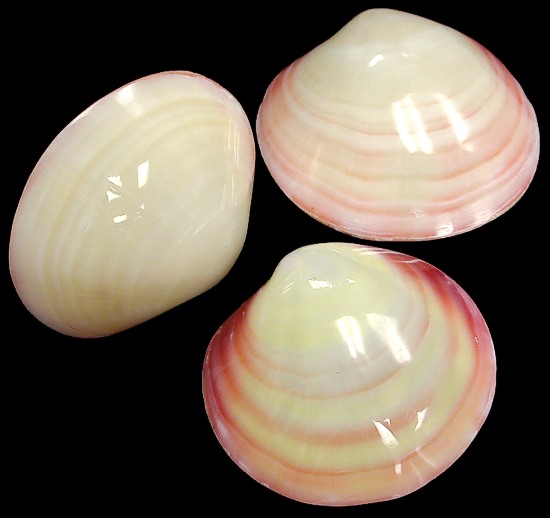
Tiger Clam Polished Complete (matching to and bottom) Shell
C1-15
A Polished complete Tiger Clam pair Shell measuring 3 to 4 inches...... $5.25
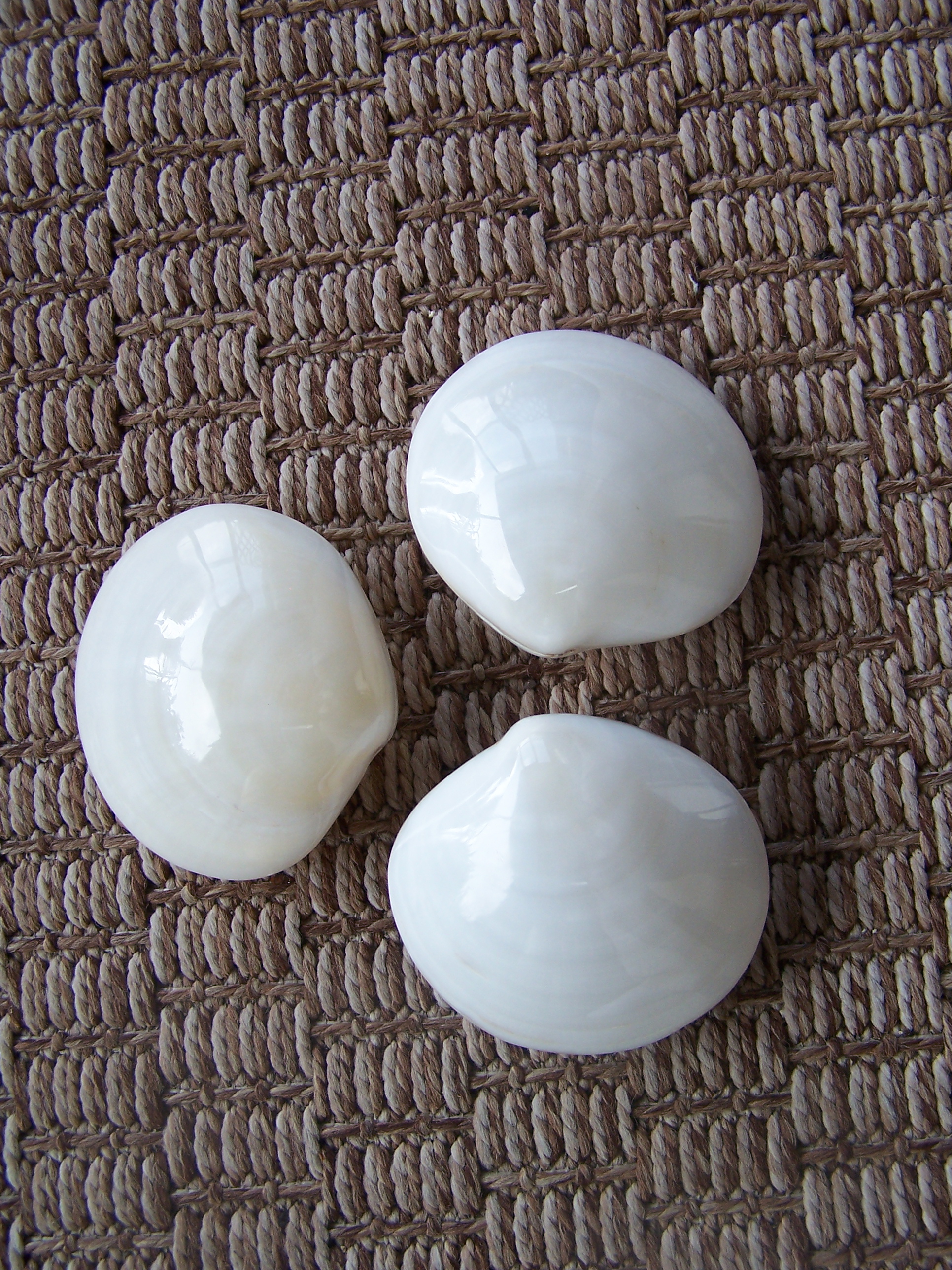
POLISHED ALBINO TIGER CLAMS
The top & bottom shell have been fused together and cannot be separated.
AC1-15
A highly polished complete Albino Tiger Clam shell measuring 3 to 4 inches... $5.25
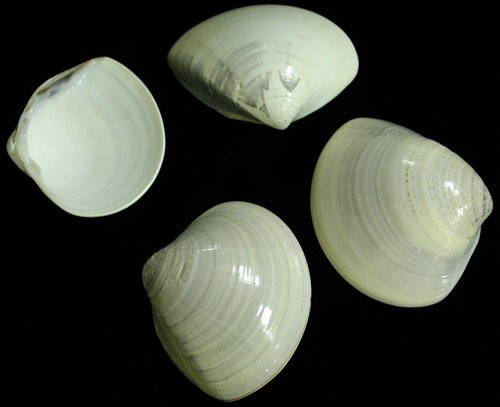
Baby Quahog Clam shell
Q0-8
One quarter pound Baby single Quahog Clam shell measuring 1.5 to 2.5 inches .......$6.95
Mercenaria mercenaria
common names hard clam, the round clam, hard-shell (or hard-shelled) clam, or the quahog.
The quahog is an edible marine bivalve mollusk that is native to the eastern shores of North America and Central America from Prince Edward Island to the Yucatán Peninsula. It is one of many unrelated edible bivalves that in the United States are frequently referred to simply as clams.In fish markets, there are specialist names for different sizes of the quahog clam. The smallest legally harvestable clams are called countnecks or peanuts, next size up are littlenecks, then topnecks. Above that are the cherrystones, and the largest are called quahogs or chowder clams.
Hard clams or quahogs are quite common throughout New England, north into Canada, and all down the Eastern seaboard of the United States to Florida; but they are particularly abundant between Cape Cod and New Jersey, where seeding and harvesting them is an important commercial form of aquaculture.
Historically, Native Americans used the quahog as a component in wampum, the shell beads exchanged in the North American fur trade. The Narragansetts used the hard clam for food and ornaments.
Rhode Island is situated right in the middle of "quahog country" and has supplied a quarter of the U.S.'s total annual commercial quahog catch. The quahog is the official shellfish of the U.S. state of Rhode Island. The species has also been introduced and is farmed on the Pacific coast of North America and in Great Britain and continental Europe. It reproduces sexually by females and males shedding gametes into the water.
The term "red tide" refers to an accumulation of a toxin, such as saxitoxin, produced by marine algae. Filter-feeding shellfish are affected, such as clams, oysters, and mussels. The toxin affects the human central nervous system. Eating contaminated shellfish, raw or cooked, can be fatal. Some other kinds of algal blooms make the seawater appear red, but red tide blooms do not always discolor the water, nor are they related to tides.
Scientific classification
Domain: Eukaryota
Kingdom: Animalia
Phylum: Mollusca
Class: Bivalvia
Order: Venerida
Superfamily: Veneroidea
Family: Veneridae
Genus: Mercenaria
Species: Mercenaria mercenaria
Binomial name: Mercenaria mercenaria
Linnaeus, 1758
(REF: Harte, M. E. 2001. "Systematics and taxonomy, Chapter 1", pp. 3–51, in Kraeuter, J. N. and M. Castagna (eds.) "Biology of the Hard Clam", Developments in Aquaculture and Fisheries Science, Vol. 31)(REF: Rice, M.A. (1992). The Northern Quahog: Biology of Mercenaria mercenaria. Rhode Island Sea Grant Publication No. RIU-B-92-001, University of Rhode Island, Narragansett. 60 pp)(REF:Eldridge, P.J., W. Waltz, and H. Mills. 1975. Relative abundance of Mercenaria mercenaria notata in estuaries of South Carolina. Veliger 18 )(REF: "Paralytic Shellfish Poisoning". Washington State Department of Health. 2020. Retrieved 10 August 2020. "Paralytic Shellfish Poisoning". Centre for Disease Control, British Columbia Health Services Authority. 2020)

Baby Pink Clams pairs are bivalves. They have matching top and bottom shells. These species are found along the Atlantic shore line.
AA1-17
Six complete Baby Pink Clams measuring 1 to 1.5 inches in size........ $7.85

VENUS CLAM
BB0-7
Four complete Venus Clam pairs, 2.5 to 3.5 inches in size...... $8.29
Venus clam is a genus of small to large saltwater clams in the family Veneridae, which is sometimes known as the Venus clams and their relatives. These are marine bivalve mollusks. There are more than 500 clams that belong to this venus clam family.
They have a matching top and bottom shell, hinged together by a ligament. Often called Butterfly-wing Venus. These are elegant, boat shaped, porcelain like shell. The shell has broad forward pointing umbones and is rounded at the front and rear. Flattened ribs cover the outer shell and are separated by narrow grooves. The hinge is thin and has a long ligament and three cardinal teeth.
This Venus clam specie is yellowish orange, spotted and flecked with pale brown and have interrupted reddish brown rays.These shells are found across the Indo-Pacific region in sandy shallow water. They are not rare, moderately common.
Scientific classification
Domain: Eukaryota
Kingdom: Animalia
Phylum: Mollusca
Class: Bivalvia
Order: Venerida
Superfamily: Veneroidea
Family: Veneridae
Genus: Venus
Linnaeus, 1758
(REF:Linnaeus (1758). Systema Naturae (10th ed.)(REF: Linnaeus (1767). Systema Naturae (12th ed.)(REF: Philippe Bouchet, Mark Huber & Serge Gofas (2012). "Venus Linnaeus, 1758". WoRMS. World Register of Marine Species. )
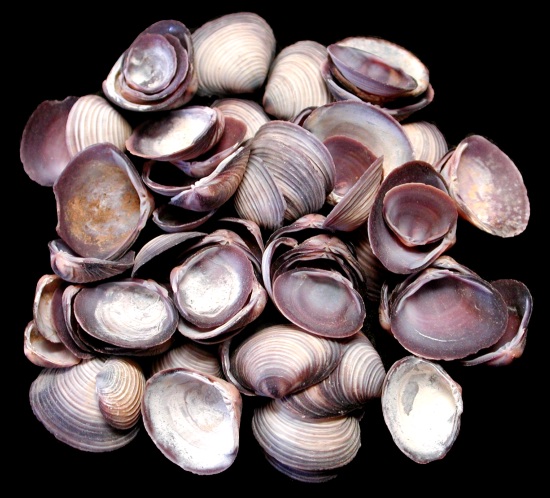
Violet Clam shells
Violet clams are bivalves. They are a common shell and attractive for their color and size for various craft projects. These clams are sold as single shells. They are not sold as a matching upper and lower shell.
V0-10
One quarter pound of single Violet Clam shells, shells measuring approximately 1/2 inch........ $5.89

Purple Baby Clams
Purple Baby Clams are bivalves. (We are not offering the matching upper and lower shell in this listing). They are shore line species found in shallow water.
V2-10
One quarter pound of Purple Baby Clam shell Singles measuring 1/2 to 1 inch...… $5.75
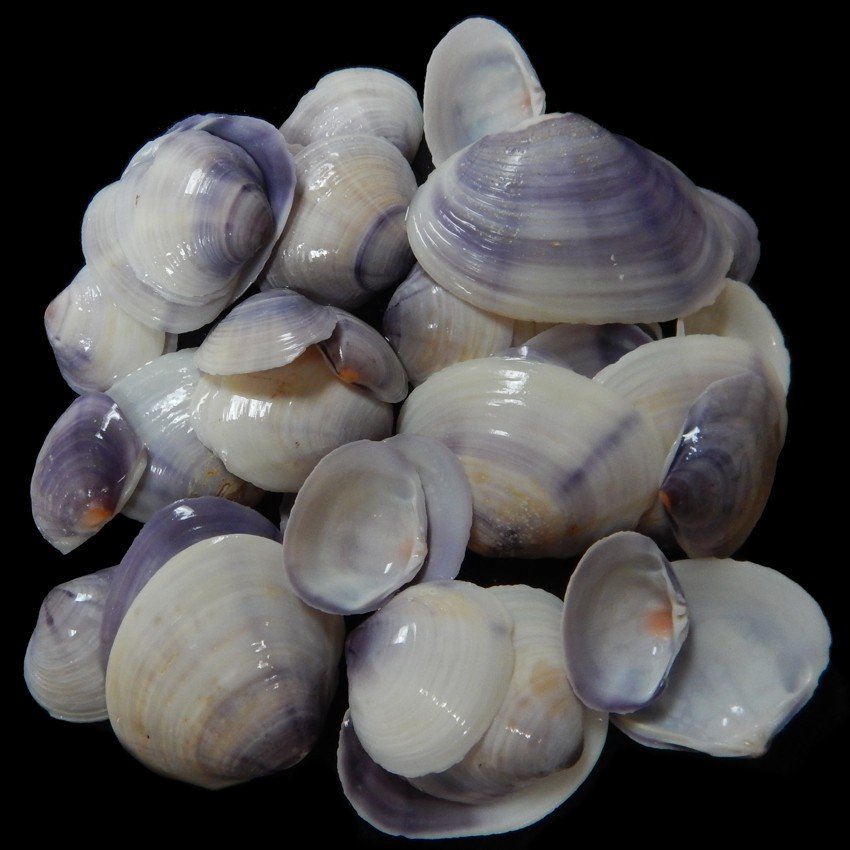
Purple Tahiti Clams
PCH1-15
One quarter pound of Purple Tahiti Clams measuring 3/4 to 1 1/2 inches..... $6.39

Bittersweet Polished Clam Pairs
Family: Glycymerididae. Species. Glycymeris. Common Name. European Bittersweet.Type. Bivalve with matching top and bottom shell joined with a ligament.
European Bittersweet Clams are solid, thick shells with an outline that is almost circular. The ligament occupies a broad, triangular area below the centrally placed umbones.
The shell color is White with dark and pale brown markings in bands and zigzags. This species has a dark brown periostracum.
periostracum is a thin, organic coating (or "skin") that is the outermost layer of the shell.
They dwell across the North Atlantic European shore South to the Northern African shore. They prefer mud and sandy sea floor and are found offshore. They are considered relatively common.
Scientific classification
Domain: Eukaryota
Kingdom: Animalia
Phylum: Mollusca
Class: Bivalvia
Order: Arcida
Family: Glycymerididae
Genus: Glycymeris
da Costa, 1778
Type species: Arca glycymeris
Linnaeus, 1758
(REF: MolluscaBase eds. (2022). MolluscaBase. Glycymeris da Costa, 1778. Accessed through: World Register of Marine Species) (REF:Sepkoski, Jack Sepkoski's Online Genus Database )
K1-04
One approximately 2 inch Polished Bittersweet Clam Shell pair...... OUT OF STOCK
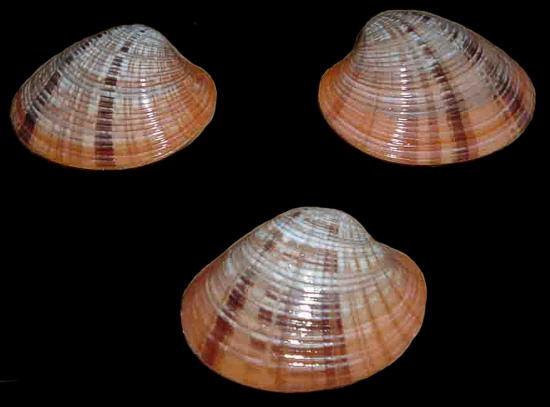
Callista Erycina Clam shell Pairs
Family. Veneridae. type. bivalve. This species is offered as a complete bivalve, with matching upper and lower shell. The matching shells are hinged together by a ligament. The ligament deteriorates shortly after the clam dies. The shells are shipped as pairs held together by a light adhesive. Common name. Red Callusta.
This species is considered boat shaped, with prominent umbones pointing forward. It has a long external hinge. The shell's front is more rounded than is rear. The ribs are regular spaced, broad and flattened with narrow grooves separating them.
Their Color can vary from Cream, pale brown and orange red with reddish brown rays. Inside section is yellowish white with orange reddish edges.
They dwell across the Indo-Pacific from Indian Ocean East to Northern Australian/New zealand shores. These clams can be found in sand at low tide. They are considered a moderately common shell.
G2-14
A complete Callista Erycina polished clam shell measuring 2 to 3 inches...... $5.45

Silver Clam Singles
The Silver Clam shell is a bivalve. We are selling this as a single shell rather than matching top and bottom shell of the bivalve. The shell has been polished to the inner nacre leaving a shiny silver color.
E1-15
One polished silver clam single, measuring 3 to 3 3/4 inches. ...... $5.99
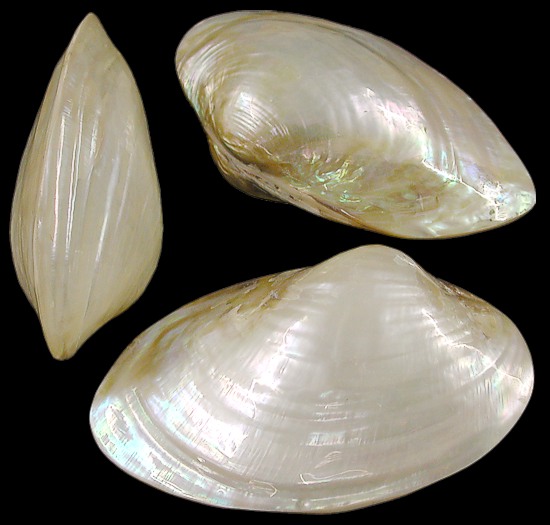
Silver Clam Pairs
The Silver Clam shell is a bivalve. We are selling this as a complete bivalve shell, with a matching top and bottom shell. The shell has been polished to the inner nacre leaving a shiny silver color.
D1-15
One complete polished Silver Clam pair Shell, measuring 3 to 3.75 inches. ...... $5.99
D2-15
One Polished complete Silver Clam shell measuring 3.75 to 5 inches ...... $6.59
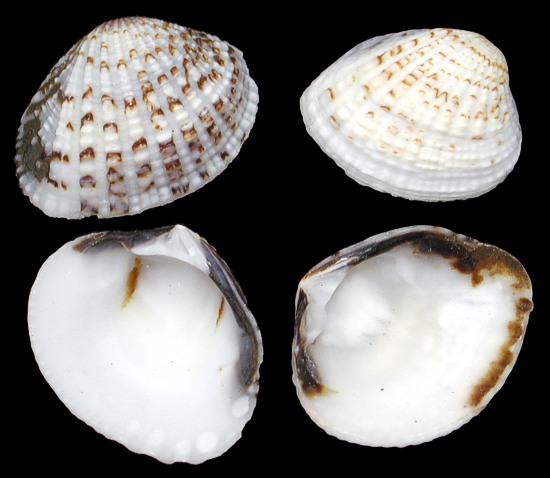
Semi White Clam Shell
Clams are bivalve shells. This means they develop a matching top and bottom shell. Our semi white clams are not sold as complete bivalves. They are sold assorted top or bottom single shell. These clams reside in tropical regions.
N1-10
One quarter pound of semi-white single clam shells, shells measuring .75 to 1.5 inches. ...... $5.89

Polished River Clam Halves
T1-4
A polished River Clam half measuring 5 to 6 inches.... $8.10